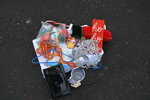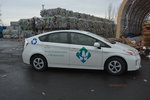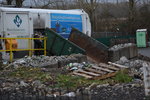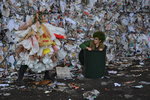



Christmastime and the celebrations that surround it are full of good times and cheer. Families and friends enjoy time together, sharing gifts packed in plastic and wrapped in paper under a tree full of glass ornaments and tinsel.
When all the fun is over, many are left with a pile of waste, some recyclable and some not, to dispose of. With a variety of materials, it can seem confusing to some, and local waste management company Waste Connections is here to help.
Ellen Ives, a waste educator at Waste Connections, said winter holidays produce a decent amount of waste that may look recyclable, such as molded plastic in toy packaging, glass tree ornaments and artificial Christmas trees that actually cannot be properly recycled and should be thrown away.
Other contaminating holiday materials include tinsel, packing pillows, ribbons, tissue paper, plastic lawn decor, strings of lights and wrapping paper with foil or glitter. Plastic lawn decor includes stuff such as a hollow plastic lawn Santa Claus, inflatable materials and hard plastic candy canes.
“Just because it’s made of plastic doesn’t mean it can be recycled,” Ives said. “Wrapping paper with glitter and foil on it also must be thrown away as it's considered contaminated.”
Garbage ending up in places it shouldn’t can contaminate entire loads of recyclable materials. One plastic Santa Claus can clog up the process at the material recovery center and cause entire loads of good recycling to be considered garbage. Ives later explained that even plastic materials with the number on the bottom can be considered contaminants. The triangular symbols with numbers inside that find themselves on the bottom of bottles and cans does not mean the item is recyclable. The number inside just describes the resin for the plastic used in the making of the product.
“To the average citizen, this symbol means an item is recyclable,” Ives said, mentioning that humans produce and use thousands of different types of plastics. “It’s not.”
Plastic packaging and lawn ornaments aren’t the only items that find themselves in the wrong bin at the curb. Batteries for toys and other handheld devices are recyclable at local facilities and should be placed in a separate container on top of the main recycling bin for proper disposal. Ives quickly mentioned that all batteries should be taped on their ends to prevent fires in trucks and at the facility.
“Just because a battery isn’t working anymore doesn’t mean it is dead,” she said. “They still hold a charge and can rub up against each other and cause a spark.”
Ives said fires due to batteries aren’t incredibly uncommon and are some of the biggest dangers to workers at the facility and in the trucks at Waste Connections, and most batteries the facilities see are not taped up.
“We really want to get the word out about taping,” she said.
Batteries aren’t the only byproduct of the holidays, and after they’re over, the trees look a little worse for wear. While plastic artificial Christmas trees are not recyclable, real ones make their way to the compost, if disposed of correctly. Trees must be cut up into 5-foot sections and placed into your yard cart for a free disposal or next to the cart for disposal with a fee. All lights, wires, tinsel, ornaments and other inorganic matter must be removed from the tree prior to pickup. Wreaths and other organic matter can also be placed into the cart for disposal.
Educating the public on proper disposal of waste is Ives’ favorite part about working for Waste Connections. Prior to taking up her position as educator at the company, she taught proper disposal techniques as a teacher in her classroom. Now she works with the company to educate children (and the greater population) in schools and through videos about proper waste management. This year, she has worked with a team to create videos featuring Oscarina the Grouch, who lives in a trash can, and Bagzilla, a monster made up of 500 plastic grocery bags (the average one person uses in a year). Ives said Bagzilla tells people to take their grocery bags back to the store to be recycled (most grocery stores have a drop off at the front of the store). Recycled grocery bags are not reused as shopping bags again. According to Ives, most of the local stores ship the bags down to Portland to be created into Trex-style composite decking.
Plastic bags aren’t the only recycled materials that find their way to the city south of the Columbia River. Glass processed at local facilities makes its way to Portland to be refined into dust and remade into bottles, jars and more. Ives said that most glass jars and bottles are recyclable. However, other glass material such as windows, mirrors and their ilk should be thrown away.
Bagzilla and Oscarina teach kids about the benefits of recycling and how the process works. In the past, much of the recycling the United States produced was shipped across the Pacific Ocean to China. In recent years, China has closed its borders to waste, and most of the recyclable materials in the United States stay on the North American continent. While glass stays along the Columbia River, Ives said aluminum cans usually find their way down to California or Kentucky. Cardboard and paper end up in Longview to be processed. Plastics can go many different places, including Canada.
Properly disposing of holiday goods and other waste isn’t the only way to help out Waste Connections and the greater Washington community. Many items thrown into the trash can instead be given away or repurposed.
“You absolutely would not believe the kind of stuff people throw away,” Ives said.
Ives explained that she has seen people throw away kayaks, furniture, cellphones and more that can and should be repurposed to a different home. Working cellphones can be donated to local shelters, and kayaks can be given to friends and family or donated.
“People throw it away because it’s the easiest thing to do,” Ives said. “It’s also by far the most expensive way to dispose of stuff.”
Ives said the West Vancouver Materials Recovery Center disposes of 250 31-ton containers of garbage a week (nearly 60 a day) and once an item makes its way onto the floor of the garbage reclamation site, it can no longer be taken back by anyone, even if it's reusable or recyclable.
“It all goes down to Boardman, Oregon to be thrown into a landfill. It makes me sad to see all of the stuff that can be reused end up in there,” she said.
While there are many rules to recycling, learning them is an important step to ensure systems move smoothly at the center. To help with the process, Waste Connections built the app Recycle Right. In the app, users can find out what days the garbage and recycling will be picked up at their address as well as look up any item and see how to correctly dispose of it.
“If there is an item that isn’t in there, tell us and we will put it in there,” Ives said.